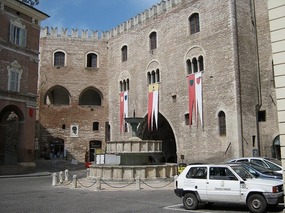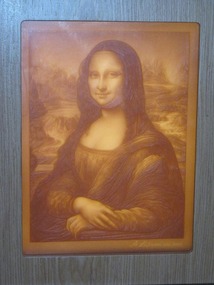We had an easy start to the day (as planned) then headed off to Fabriano, the biggest town near here. We had decided that less is more and midday breaks were essential.
We first went to the market which was disappointing as it was the smallest we have been to and the fruit didn't seem to be as good
. We then looked around the centre which is a triangular shape rather than the usual square. There was a nice Gothic arch (dating to 1255) the town hall (from the 14th century) and the 17th century clock tower, amongst a number of other historic buildings.
We then made our way to the Paper and Watermark museum which was our main reason for coming here. We had not realised that paper had been made here since the 12th century and that the paper for printing the Euro notes is done here today.
The museum was in a former convent. There was an inner courtyard with some displays, other displays on the ground floor and the tour finished upstairs. The downstairs part, including a video, went through the history of papermaking. When paper was first made in the area it was made from rags. The secrets of the process were restricted to people in the town and the paper was very like blotting paper so not used for anything official
. Once they learned how to fix the surface the town became wealthy. The idea of and the method of making watermarks developed here. There was a man actually making sheets of paper the old-fashioned way and it had various watermarks on it also.
The general history of paper making was shown and then how it developed in Fabriano. Rags became hard to source during the plague and other areas made advances. But then the area revived, wood pulp was used and now there are a number of paper firms in the town.
The displays upstairs showed the early watermarks from the 14th century when they were used to prove the paper was genuinely made using the specified mark. In recent times they have become much more complicated, partly for security but also they have become genuine works of art. We also saw a room with cardboard furniture which was surprisingly comfortable.
We bought a rotisserie chicken on the way back to the car and retuned for a picnic style lunch and to have a break until 3.30pm. This worked really well as John was able to stay cool and I could still sit in the warmth for part of the time reading.
We then set out to visit the largest caves in Italy, the Caves of Frasassi. They are less than 30 minutes away and as the temperature is a constant 14 degrees are a lovely cool place
. They have tours in English as well as Italian – and we were part of a group of 11. Thanks to Jeni Lemburg we again showed our Teaching card and got a discount. The parking place and ticket office is about 1 km from the cave entrance and you are delivered there by bus. Our bus to the site had 4 people aboard.
We found the guide and waited while she found the rest of the group. Then, (only in Italy), we had to wait for the last couple to finish their cigarettes. There were a lot of signs that said no cameras, the guide told us no photographs of any kind but the guy who had been smoking took a photo and then claimed not to know!!
The caves were amazing. They were only discovered in 1971when a caving group went down a crack in the mountain and felt a rush of air. They dropped stones and when it took 6 seconds for them to hit the bottom they knew it was a big cave. This proved to be the biggest cave in the system of 7, now called 'the Cave of the Wind’. It is 180m long, 120m high and 200m wide. The guide pointed to a small stalactite – then said it was over 2m high. The size of things is disguised by the size of the space.
There were the usual shapes pointed out as looking like a camel, a polar bear, a wise man and Santa – which (with imagination) they did. But the whole place was just wonderful. We saw a 7m stalactite that looked tiny as the cavern is so high. We saw new stalactites, called spaghetti, which are from 100 to 1000 years old and hollow, like drinking straws. We also saw blades – calcium structures that grow from the side of the caverns.
The guide went through the history of the cave development – basically the river carved out the land, the mountains rose, the sandstone eroded and caves resulted. This was helped by the sulphuric acid that is still found in pot holes and can be smelt in the outside area.
I especially liked the display they called mini Niagara. It was white crystalline calcite so very pure with a sparkle and really did look like falls, or fine wedding icing. We noticed that a lot of the stalagmites were flat on top. There was a lot of water lying in the bottom of the caves. In places the cave was 300m but there was 900m of rock above.
The guide told us that the lights in the cave are special non heat producing and turned off at night. There are a few creatures living in the cave, unusual because the food chain starts with sulphur feeders. The largest is a 6cm long creature like a lizard, but blind.
When we got back we ate the last of Nico’s sauce with some new pasta and the left over chicken. We had figs for dessert courtesy of Jane who had got them from a friend. When she said she had got figs I asked were I could buy them. You can’t – they grow like a weed and people just give them away!! We ate 6 for dessert, then sorted the blogs before heading to bed.
Taking notes in Fabriano
Wednesday, June 30, 2010
 Cupramontana, The Marches, Italy
Cupramontana, The Marches, Italy
Other Entries
-
26Meeting Margo in Marburg
Jun 1317 days prior Marburg, Germanyphoto_camera6videocam 0comment 0
Marburg, Germanyphoto_camera6videocam 0comment 0 -
27Out and about in Marburg
Jun 1416 days prior Marburg, Germanyphoto_camera6videocam 0comment 0
Marburg, Germanyphoto_camera6videocam 0comment 0 -
28The football in Marburg
Jun 1515 days prior Marburg, Germanyphoto_camera2videocam 0comment 0
Marburg, Germanyphoto_camera2videocam 0comment 0 -
29Exploring Hesse
Jun 1614 days prior Marburg, Germanyphoto_camera14videocam 0comment 1
Marburg, Germanyphoto_camera14videocam 0comment 1 -
30South to the Alsace
Jun 1713 days prior Mittelbergheim, Francephoto_camera6videocam 0comment 1
Mittelbergheim, Francephoto_camera6videocam 0comment 1 -
31Vins des Pay
Jun 1812 days prior Mittelbergheim, Francephoto_camera6videocam 0comment 1
Mittelbergheim, Francephoto_camera6videocam 0comment 1 -
32Strasbourg and Beyond
Jun 1911 days prior Mittelbergheim, Francephoto_camera14videocam 0comment 0
Mittelbergheim, Francephoto_camera14videocam 0comment 0 -
33Back to Bodensee
Jun 2010 days prior Meersburg (Bodensee), Germanyphoto_camera5videocam 0comment 0
Meersburg (Bodensee), Germanyphoto_camera5videocam 0comment 0 -
34Exploring Bodensee
Jun 219 days prior Meersburg (Bodensee), Germanyphoto_camera15videocam 0comment 0
Meersburg (Bodensee), Germanyphoto_camera15videocam 0comment 0 -
35Tratorria da Nando
Jun 228 days prior Barcarola, Italyphoto_camera9videocam 0comment 1
Barcarola, Italyphoto_camera9videocam 0comment 1 -
36Where eagles dare
Jun 237 days prior Barcarola, Italyphoto_camera8videocam 0comment 2
Barcarola, Italyphoto_camera8videocam 0comment 2 -
37Conquering the Valdastico hairpins
Jun 246 days prior Barrcarola, Italyphoto_camera11videocam 0comment 0
Barrcarola, Italyphoto_camera11videocam 0comment 0 -
38On the road with Nico
Jun 255 days prior Barcarola, Italyphoto_camera18videocam 0comment 0
Barcarola, Italyphoto_camera18videocam 0comment 0 -
39On the road to La Marche
Jun 264 days prior Cupramontana, Italyphoto_camera6videocam 0comment 2
Cupramontana, Italyphoto_camera6videocam 0comment 2 -
40Settling in at Cupramontana
Jun 273 days prior Cupramontana, Italyphoto_camera11videocam 0comment 0
Cupramontana, Italyphoto_camera11videocam 0comment 0 -
41Sun, sand and Sirolo
Jun 282 days prior Cupramontana, Italyphoto_camera7videocam 0comment 0
Cupramontana, Italyphoto_camera7videocam 0comment 0 -
42Discovering Umbria
Jun 291 day prior Cupramontana, Italyphoto_camera6videocam 0comment 0
Cupramontana, Italyphoto_camera6videocam 0comment 0 -
43Taking notes in Fabriano
Jun 30 Cupramontana, Italyphoto_camera3videocam 0comment 0
Cupramontana, Italyphoto_camera3videocam 0comment 0 -
44Mountain Monastery
Jul 011 day later Cupramontana, Italyphoto_camera11videocam 0comment 0
Cupramontana, Italyphoto_camera11videocam 0comment 0 -
45A lazy Le Marche day
Jul 022 days later Cupramontana, Italyphoto_camera5videocam 0comment 0
Cupramontana, Italyphoto_camera5videocam 0comment 0 -
46Welcome to Florence
Jul 033 days later Florence, Italyphoto_camera10videocam 0comment 0
Florence, Italyphoto_camera10videocam 0comment 0 -
47Discovering Florence
Jul 044 days later Florence, Italyphoto_camera12videocam 0comment 1
Florence, Italyphoto_camera12videocam 0comment 1 -
48Tunnels and tolls
Jul 055 days later Villarodin-Bourget, Francephoto_camera4videocam 0comment 2
Villarodin-Bourget, Francephoto_camera4videocam 0comment 2 -
49Ascending the Alps
Jul 066 days later Villarodin-Bourget, Francephoto_camera29videocam 0comment 0
Villarodin-Bourget, Francephoto_camera29videocam 0comment 0 -
50From mountains to motorways
Jul 077 days later Toulouse, Francephoto_camera6videocam 0comment 0
Toulouse, Francephoto_camera6videocam 0comment 0 -
51The fleas that tease....
Jul 088 days later Toulouse, Francephoto_camera9videocam 0comment 2
Toulouse, Francephoto_camera9videocam 0comment 2 -
52Back to Basics
Jul 099 days later La Bessede, Francephoto_camera11videocam 0comment 0
La Bessede, Francephoto_camera11videocam 0comment 0 -
53Living on the River
Jul 1010 days later Loches, Francephoto_camera11videocam 0comment 0
Loches, Francephoto_camera11videocam 0comment 0 -
54Chateaus and caches
Jul 1111 days later Loches, Francephoto_camera14videocam 0comment 0
Loches, Francephoto_camera14videocam 0comment 0 -
55A rewarding search
Jul 1212 days later Méautis, Francephoto_camera6videocam 0comment 0
Méautis, Francephoto_camera6videocam 0comment 0 -
56The Normandy Beaches
Jul 1313 days later Méautis, Francephoto_camera21videocam 0comment 0
Méautis, Francephoto_camera21videocam 0comment 0 -
57Mont Saint Michel and Battlefields
Jul 1414 days later Méautis, Francephoto_camera18videocam 0comment 0
Méautis, Francephoto_camera18videocam 0comment 0 -
58Biking in Bruges
Jul 1515 days later Bruges, Belgiumphoto_camera10videocam 0comment 3
Bruges, Belgiumphoto_camera10videocam 0comment 3 -
59Bruges and beyond
Jul 1616 days later Bruges, Belgiumphoto_camera27videocam 0comment 0
Bruges, Belgiumphoto_camera27videocam 0comment 0 -
60Flander's Fields
Jul 1717 days later Bruges, Belgiumphoto_camera21videocam 0comment 1
Bruges, Belgiumphoto_camera21videocam 0comment 1 -
61Living by the canal
Jul 1818 days later Schoorldam, Netherlandsphoto_camera26videocam 0comment 0
Schoorldam, Netherlandsphoto_camera26videocam 0comment 0

 Cupramontana, The Marches, Italy
Cupramontana, The Marches, Italy







2025-05-23